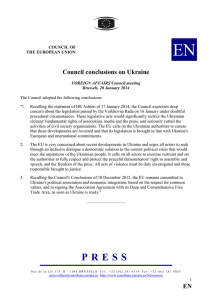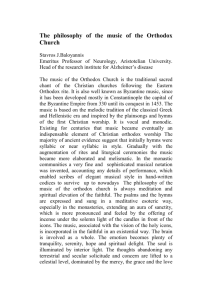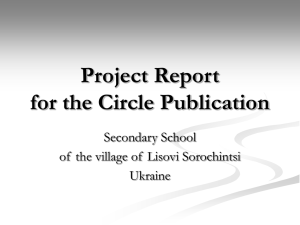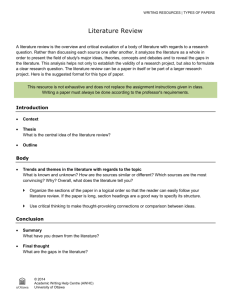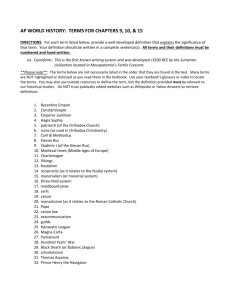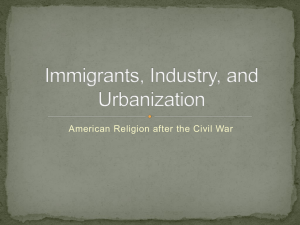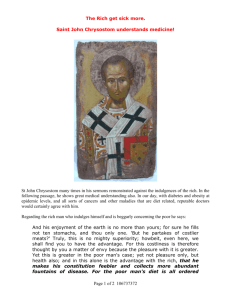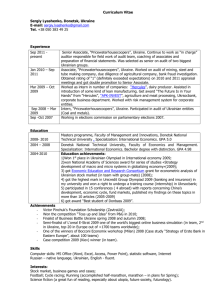Unit 2: Religious History--Ukraine Objectives Be aware of the following
advertisement
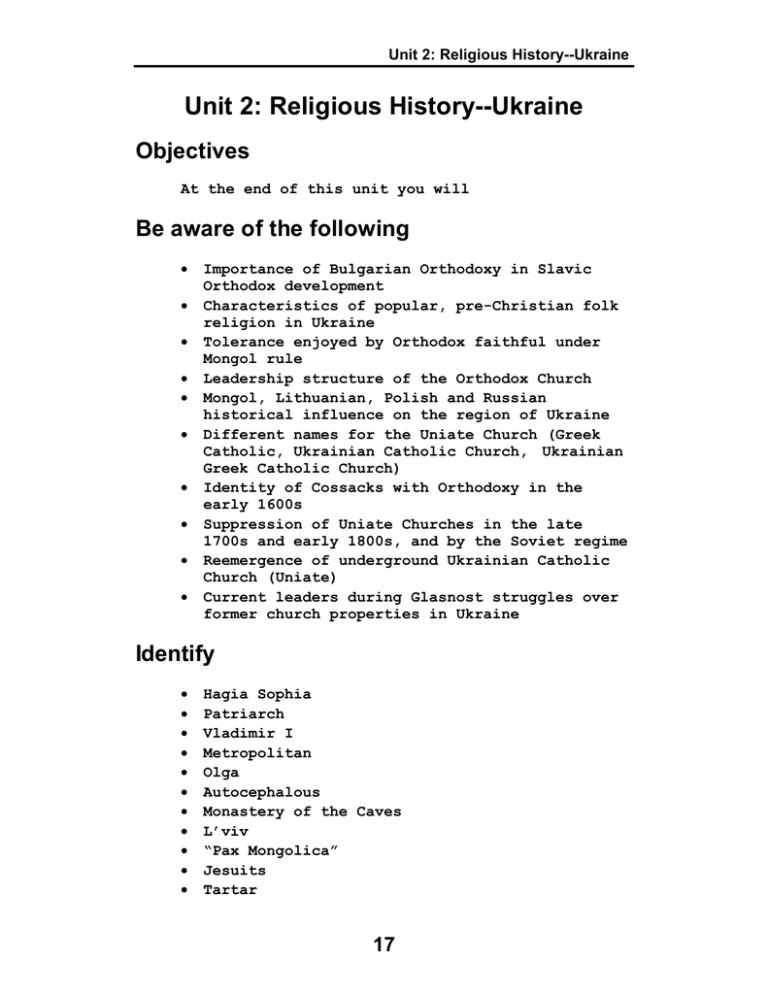
Unit 2: Religious History--Ukraine Unit 2: Religious History--Ukraine Objectives At the end of this unit you will Be aware of the following • Importance of Bulgarian Orthodoxy in Slavic Orthodox development • Characteristics of popular, pre-Christian folk religion in Ukraine • Tolerance enjoyed by Orthodox faithful under Mongol rule • Leadership structure of the Orthodox Church • Mongol, Lithuanian, Polish and Russian historical influence on the region of Ukraine • Different names for the Uniate Church (Greek Catholic, Ukrainian Catholic Church, Ukrainian Greek Catholic Church) • Identity of Cossacks with Orthodoxy in the early 1600s • Suppression of Uniate Churches in the late 1700s and early 1800s, and by the Soviet regime • Reemergence of underground Ukrainian Catholic Church (Uniate) • Current leaders during Glasnost struggles over former church properties in Ukraine Identify • • • • • • • • • • • Hagia Sophia Patriarch Vladimir I Metropolitan Olga Autocephalous Monastery of the Caves L’viv “Pax Mongolica” Jesuits Tartar 17 Unit 2: Religious History--Ukraine • Metropolitan Sheptytsky • Ukrainian Autocephalous • Ukrainian Orthodox Church--Moscow Patriarchate (UOC-MP) • Ukrainian Orthodox Church--Kiev Patriarchate (UOC-KP) • 1993 Non-native Religious Restriction Act Realize • Cultural center the Monastery of the Cave became for Ukraine during medieval times • Deeply held passions which Ukrainian religious identity can foster • Complicated religious picture of Orthodoxy in the Republic of Ukraine • Historical influence leading to the Union of Brest (1596) • Roughly half of the Soviet Union’s Russian Orthodox adherents were located in the Ukraine • Current conditions with Ukraine’s Orthodox Churches 18 Unit 2: Religious History--Ukraine Unit 2: Religious History--Ukraine I. Orthodox Beginnings 1. Byzantine Civilization (BIZ-ahn-teen) Under the rule of Roman emperor Constantine I (ruled A.D. 324337) and Theodosius I (thee-ah-DOH-shee-ahs, A.D. 379393), Christianity became Rome’s established religion. Constantine chose as the new capital of the Roman Empire Constantinople, formerly called Byzantium. In time, Constantinople surpassed Rome in importance. While Rome was sacked by Ostrogoths (OS-trah-goth) in A.D. 476, Constantinople (the “second Rome”) continued as the head of the Eastern Roman Empire for another 1,000 years. a. Hagia Sophia Constantinople’s Church of Divine Wisdom or Hagia Sophia (high-EE-ah) was the center of Eastern Orthodoxy. Built by Justinian in the sixth century, it was the largest and most splendid Christian religious structure then in existence. The liturgy (formal public worship service) of this church, called the ninth-century Byzantine Rite, became the common worship pattern for Eastern Orthodox churches. b. Mission movements Expansion of Byzantine Christianity occurred throughout eastern Europe. Greek Orthodox missionaries St. Cyril (SIR-ahl, A.D. 827-869) and his brother St. Methodius (mah-THOO-dee-ahs, @825885), the “Apostles to the Slavs,” spread Orthodoxy to the Slavic peoples of the Balkan Peninsula. In the ninth century, Bulgaria became an Orthodox nation under Tzar Boris (852-889), establishing its own administratively independent patriarchate (place of official church jurisdiction). Bulgarian religious leaders would serve as intermediaries for Orthodox faithful until 1448. 19 Unit 2: Religious History--Ukraine c. Kievan Russia interaction Exchanges in trade and culture between the Byzantine empire and Russia took place from early times. By the time of Vladimir I, contacts also were maintained with Muslims near the Volga River and southeast regions as well as with Jewish Khazars. d. Vladimir I When envoys of Kievan prince Vladimir went looking for a religion for the Rus to follow, their report from Constantinople’s Hagia Sophia won over Vladimir. Reported the emissaries, “We knew not whether we were in heaven or on earth, for surely there is no such splendor or beauty anywhere upon earth.” e. Impact of Vladimir’s decision In choosing the Eastern flank of Christendom, the following significant trends of thought and practice entered Russian/Ukrainian culture. (1) Byzantine culture Vladimir opened and fused Ukraine to the highly developed Byzantine culture of the time. Ukrainians and Russians engaged in trade and commerce with their Eastern counterparts. They adopted and adapted Byzantine architecture and art. (2) Isolation and suspicion of the West In part, the early Russians and some Ukrainians turned their backs on tenth century European, Latin, non-Christian civilizations. Isolation from and suspicion of the rest of Europe were a long term result. (3) Church and state In Byzantium, church/state religions tended to commingle. The civil head of state was closely allied to the Church. Legally, the emperor had an obligation for the moral development of the people. A sense of community, 20 Unit 2: Religious History--Ukraine brotherhood and togetherness, embodied in law and church tradition, became commonplace. (4) National culture Historian Nicholas Riasanovsky argues that Vladimir’s choice of Constantinople “represented the richest and the most rewarding spiritual, cultural and political choice that he could make at the time...it brought religion, in the form of a readily understandable Slavic rite, close to the people and gave a powerful impetus to the development of a national culture” (p. 36). Literature, education and the arts in Kievan Russia thus came under the influence of the Church. (5) Saints Over a period of time, and often delayed or opposed by Church leadership in Constantinople, the Kievan church canonized saints. Vladimir, the baptizer of Russia, and his mother Olga, the first famous woman in Russian/Ukrainian history and first Christian ruler of Kiev, became saints. Saints Anthony (982-1073) and Theodius (d. 1074) were ascetic monks who created and organized the Monastery of the Caves near Kiev. Not only the struggles of the soul, but social service to the needy-whether princes or the hungry poor-became the model of these saint inspired monastic communities. f. Dvoeverie (dvoh-yeh-vyer-EE-yeh) Despite the impact of Vladimir’s decision to accept Orthodox Eastern Christianity, all classes and peoples did not immediately drop pre-Christian ways. The extent and content of belief in these lower classes is a matter of scholarly dispute. For Ukrainian peoples folk belief included recognition of a variety of spirits: those of the forest, fields and streams, and various buildings. A mermaid (rusalka or mavka), though dangerous, was thought to bring moisture and fertility to crops. 21 Unit 2: Religious History--Ukraine Folk morals included respect and love of free labor; kindness, beauty and knowledge of genealogy and civic duties. Drunkenness, laziness, insincerity and stinginess were all condemned. The term “dvoeverie” describes popular Slavic religion. When pagan beliefs and practices are preserved under the veneer of Christianity, that is “dvoeverie.” In the borderlands and within rural communities during Vladimir’s time, pagan survivals remained. Some argue that for the masses, even to this present day, dvoeverie characterizes popular religion (See “Dvoeverie and Popular Religion” by Eve Levin in Seeking God: The Recovery of Religious Identity in Orthodox Russia, Ukraine, and Georgia, ed. Stephen Batalden, pp. 31-33). 2. Mongol Invasion and Rule (@1240-1480) Under Genghis Khan (GENGgah SKAHN), Mongols (MONG-gahl, called Tartars [TAHR-tahr] or Tatars in early Russian sources) sacked Kiev in 1240. Showing internal strength and great administrative flexibility, the Orthodox Church survived throughout this period. Aspects of church life under the Mongols include the following. a. Tolerance Though the Mongols had troubles in their success in working with ruling princes, tolerance marked their associations with the Russian Orthodox hierarchy. Under the Mongols, church lands and priests received tax exemption. Church authorities legislated both civil and criminal judicial cases. b. Orthodox invigoration During this period, the status of the church improved. Wealth increased. “Christianization,” whereby church influence extended to the far expanses of the countryside, continued. With the diffusion of power amongst many different princes, Orthodoxy--tolerated by the Mongols--became the one unifying force in the increasingly fragmented Kievan region. A “Pax Mongolica,” an era of relative 22 Unit 2: Religious History--Ukraine peace and stability, was the prevailing climate until Lithuania expanded over much of Kievan Ukraine in the 1390s and the Ottoman Turks took control--from the Mongols--of Crimea and southern Ukraine by 1475. c. Monastic communities Before the thirteenth century, some seventy monasteries were in existence in Kievan Rus. One type of community consisted of hermits who congregated together only for Sunday services. Another monastic pattern was that of a disciplined and centralized community under the authority of an abbot. The Monastery of the Caves, founded by Saints Anthony and Theodius in 1015, was the most influential of these monastic communities. It became a primary center for Kievan cultural life. Monks at the Monastery of the Caves penned The Primary Chronicle (Povest vremennykh let [Tale of Bygone Years]), an account of the historical foundations of Iaroslav the Wise’s policies and arguments for a centralized Kievan state. Fourteenth and fifteenth century editions of this work currently exist. II. Reformation, Counter-Reformation and the Union of Brest 1. Background a. Framework Before launching on a discussion of the complicated Orthodox Church picture in the Ukraine, a review of the following terms and concepts, central to Orthodoxy, is helpful. 23 Unit 2: Religious History--Ukraine (1) Leadership (a) Patriarch In Orthodoxy, the chief leader of the church in a given country or nation state is a patriarch. A patriarch oversees an entire national section of the church. To use a military analogy, a patriarch is like the commanding general. (b) Metropolitan Provinces or sections of the national church are overseen by metropolitans. A metropolitan is like a bishop, or, in military terms, a brigade commander (colonel). (c) Patriarchates The jurisdiction, or area over which a patriarch rules, is the patriarchate. In Orthodoxy, Rome, Alexandria, Antioch, Constantinople and Jerusalem are the historic patriarchates. Of these, the patriarch of Constantinople is the “first among equals” or the most respected authority. In the military analogy, the patriarch of Constantinople is somewhat like the Chairman of the Joint Chief’s of Staff. (2) Autocephalous (AH-tah-SEF-ah-lahs, “selfgoverning”) Each patriarch is a self-governing leader. Though in communion with other Orthodox churches, a patriarch’s jurisdiction is independent of others. In the military analogy, the army, navy, coast guard, marines or air force are each independent, selfgoverning (autocephalous) branches who nonetheless work together. (3) Roman Catholic Church Orthodoxy is not just another cousin or branch of the Roman Catholic Church. The head of the Roman Catholic Church is the Pope in Rome. Distinct liturgy, doctrine and practice govern Catholic and Eastern Orthodox faithful. b. Ukraine particularities (1) Patriarchates The metropolitan in Moscow did not become a patriarch until Patriarch Jeremias II of Constantinople designated the Moscow patriarchy in 24 Unit 2: Religious History--Ukraine 1589. Moscow oversaw Orthodoxy in the Ukraine for centuries before and after 1589. Kiev--though the historic center of Russian (and Orthodox) culture--did not have a patriarch (did not become independent or self-governing [autocephalous]) until 1 Jan 1919. (2) “Borderlands” Historically, the region of present day Ukraine came under the political, social, and cultural domination of Mongols, Lithuania and Poland (1349-1569) or Russia for much of her existence. Roman Catholic practice was the norm in Poland and Lithuania, Russian Orthodoxy in Russia. (3) Politicized aspirations During her long history, Ukraine’s peoples have alternated between independence and dependence. In the process, church identification--a critical source of identity and national culture--became politicized. Church “politics” became national politics. Church buildings/lands became secular buildings/lands, administered by local civil authorities. Thus, church identity aroused highly inflamed, passionately held loyalties in both secular and religious spheres. Adding also the impact of Ukraine being overrun by military forces in both world wars, and the imposition of atheistic Soviet practice, the religious picture becomes involved and complicated. 2. Reformation and Counter-Reformation a. Overview During the 1400s and early 1500s, Orthodoxy increasingly suffered from church leaders who were self-serving. Political and economic power, rather than religious/spiritual oversight, became their focus. 25 Unit 2: Religious History--Ukraine The state cut off support to Orthodoxy. The patriarch in Constantinople, who had oversight of Ukraine’s Orthodox faithful, became increasingly distant and unresponsive, being forced to concern himself more and more with life under Islamic Ottoman domination. b. Monastic revival To counter this increasingly dismal spiritual picture, monastic communities became places for renewal. God’s faithful came to monasteries, rather than churches, for spiritual renewal and understanding. Monasteries did not counterbalance, however, the increasing influence of Roman Catholic Polish-Lithuanian government overseers. c. Brotherhoods Some Orthodox townspeople banded together as “bratstva” or brotherhoods. These business/professional associations promoted social activities, but more importantly served to support the Orthodox church. One of these associations, the brotherhood in L’viv (lah-VEEF, a city 300 miles west of Kiev, near the present-day Ukraine/Poland border), closely adhered to great Orthodox practice. In 1585, visiting Patriarch Joachim of Antioch gave this brotherhood unprecedented authority to supervise clergy and the Orthodox church in general. d. Protestant reformers John Calvin, Martin Luther and Unitarian thought impacted Ukraine in raising the level of education and theological discussion among educated elites. Scriptures however, remained in Church Slavonic rather than being translated into commonly understood dialects. As a result, little reformation impact occurred among the masses of Ukraine’s population. 26 Unit 2: Religious History--Ukraine e. Counter Reform In 1564, the Jesuits, a Roman Catholic religious order founded to reform the Catholic Church (in response to Protestantism) and promote foreign mission service, arrived in Polish Ukraine. Since Protestant inroads were few, the focus of Jesuit activity became “the Orthodox problem.” Peoples of the region were too “Orthodox.” Strong programs in education and publication, resulting over time to conversions to Catholic practice, resulted. f. Renewed Constantinople oversight When the Patriarch of Constantinople, Jeremias II, granted Moscow’s independence (establishing the patriarchate of Moscow and all of Russia) in 1589, he also forcefully indicated that Orthodoxy in Belarus (byay-lah-ROOS) and Ukrainian lands was to remain under the jurisdiction of Constantinople. The bishop of L’viv’s Orthodox churches, Gedeon Balaban (officiated 1569-1607), became increasingly influenced by the Roman Catholic tenor of the L’viv Brotherhood. In 1589, he petitioned L’viv’s Roman Catholic bishop to liberate Orthodoxy from “the slavery of the patriarchs of Constantinople.” This request formed the backdrop for the Union of Brest. 3. Union of Brest Several events led to the synod of Brest, 9 Oct 1596. a. Letter of intent In 1590, a number of Orthodox bishops in the Ukraine declared their intention to recognize the Pope in Rome as the head of the Orthodox church. b. Pledge Five years later, Orthodox bishops pledged allegiance to the Pope and outlined thirtythree rights as a prerequisite to union. 27 Unit 2: Religious History--Ukraine c. Papal acceptance On 23 Dec 1595, Pope Clement VIII accepted the bishops and national church into the Roman church. d. Declaration On 9 Oct 1596, the Union of Brest declaration was signed by the metropolitan of Kiev and many Orthodox bishops. As part of the agreement, Eastern Orthodox practice--liturgy, Slavonic rite, married clergy, administrative autonomy, Julian calendar-would remain. Orthodox signatories would recognize the Pope in Rome and submit to his authority. 4. Uniate Church (YOO-nee-at) Alternately called the Greek Catholic, Ukrainian Catholic Church, or Ukrainian Greek Catholic Church, the Uniate church became a unique religious body within Roman Catholic and Orthodox practice. III. Cossacks and the Orthodox Revival 1. Cossack Ukrainian Impact Freedom loving Cossacks revived Ukrainian culture in the early 1600s. Accompanying their revival was a renewed emphasis upon Orthodoxy. Latent Orthodox faithful and clergy, buoyed by the Cossack resurgence, sought restoration of dormant church organizational structure. In time, with the exception of L’viv, all leadership positions returned from Uniate to Orthodox clergy. Polish/Cossack struggles saw Roman Catholic Polish leadership favoring the Uniates, while Cossacks advocated full reconstitution of the Orthodox church. 28 Unit 2: Religious History--Ukraine 2. Compromise of 1632 This agreement saw a return of Eastern Orthodox clergy to leadership positions in the church. A Polish king confirmed the decision and the patriarch of Constantinople blessed the arrangement. Many Uniate churches and monasteries returned to Orthodox supervision. 3. Moscow Oversight In 1686, the Orthodox church in Ukraine lost her semi-independent status, becoming organically linked again to Moscow’s Russian Orthodox hierarchy. Moscow, through appointed metropolitans in Kiev, could once again lay a political, religious and cultural hand over Ukraine. IV. Imperial Russia (1682-1917) 1. Uniate Suppression In the 1770s, as a result of increasing Russian presence in Ukraine, some 1,200 Kiev region Uniate churches forcibly or voluntarily became Orthodox. Uniate churches, as symbols of Ukraine independent identity, were suppressed. Russian expansion under Catherine the Great forced over 2,300 Uniate churches to become Orthodox after 1793-1795. By 1796, the Uniate Metropolitanate of Kiev ceased to exist. In 1839, permanent abolishment of the Uniate Church occurred under Bishop Semashko. Uniate faithful “voluntarily” converted to Orthodoxy. Clergy who refused (593 of 1,898) were exiled to Siberia or interior Russia. In the mid-to-late 1800s, Uniates formally existed only in Austrian controlled areas of Ukraine (western or Galicia Ukraine). 2. Russian Orthodox Inclusion By the end of the 1700s, through a series of formal and informal incentives and agreements, Ukrainian Orthodoxy became an integral part of the Russian Orthodox Church. “In essence, the Orthodox church...became an instrument of russification and a foremost representative of the official imperial ideology, with its glorification of the tsar, Orthodoxy, and Russian nationality” (A History of Ukraine, Paul Magoisi, p. 375). 29 Unit 2: Religious History--Ukraine V. 20th Century Developments 1. Uniates (Ukrainian Catholics, Greek Catholics, Ukrainian Greek Catholics) a. Metropolitan Sheptytsky (oversight from 1900-1944) This early 20th century leader of the Ukrainian Catholic Church is called “the grand old man of the Greek Catholic Church.” Sheptytsky’s interests were many-education, theology, missions, monastic orders (both men and women), church union, and the spiritual oversight of Ukrainian emigrants to Canada and the United States. Under his leadership, L’viv became the respected center--both ecclesiastically and educationally--for Uniate Catholic practice. b. Soviet occupation “Soviet religious policy was particularly harsh toward the Ukrainian Catholic Church. Ukrainian Catholics fell under Soviet rule in 1939 when western Ukraine was incorporated into the Soviet Union as part of the Nazi-Soviet Nonaggression Pact. Although the Ukrainian Catholic Church was permitted to function, it was almost immediately subjected to intense harassment. Retreating before the German army in 1941, Soviet authorities arrested large numbers of Ukrainian Catholic priests, who were either killed or deported to Siberia. After the Red Army reoccupied western Ukraine in 1944, the Soviet regime liquidated the Ukrainian Catholic Church by arresting its metropolitan, all of its bishops, hundreds of clergy, and the more active faithful, killing some and sending the rest to labor camps, where, with few exceptions, they perished. At the same time, Soviet authorities forced some of the remaining clergy to abrogate the union with Rome and subordinate themselves to the Russian Orthodox Church” (Country Study--Soviet Union, p. 200). 30 Unit 2: Religious History--Ukraine c. L’viv Council (8-10 March 1946) Seen by many as initiated by direct order of Stalin, a church council convened at L’viv in 1946. It voided the 1596 Union of Brest. Once again, Ukrainian Catholics forcibly became Russian Orthodox. Of the 3,000 Uniate priests at the time, 1,100 submitted to Russian Orthodoxy. Sixteen hundred ended in prison. The remainder went underground. Communist authorities considered this council binding during the rest of the Soviet era. 2. Ukrainian Orthodox (Autocephalous, self-governing) a. Origins Following the rebirth of the Ukrainian state in 1917-18, Patriarch Tikhon of Moscow, the head of the Russian Orthodox Church, convened the All-Ukrainian Church Council in Kiev. By 1920, the Ukrainian Orthodox Church officially became selfgoverning. This Ukrainian Autocephalous Orthodox Church (UAOC) gathered a ready following among both peasant and intelligentsia classes. It also established roots with emigrant Ukrainians in Western Europe, Canada and the United States. b. Suppression The Soviet regime applied a “stampout” policy to the Ukrainian and Belorussian Autocephalous Orthodox Churches. “Viewed by the [Communist] government as very nationalistic, both churches were suppressed, first at the end of the 1920s and again in 1944 after they had renewed themselves under German occupation. The leadership of both churches was decimated; large numbers of priests--2,000 Belorussian priests alone--were shot or sent to labor camps, and the believers of these two churches were harassed and persecuted” (Country Study--Soviet Union, p. 199). 31 Unit 2: Religious History--Ukraine 3. Ukrainian Orthodox Church--Moscow Patriarchate (UOC-MP) After the German retreat in 1944, the Moscow based Russian Orthodox Church reestablished jurisdiction over Ukrainian Orthodox faithful. By the early 1950s, more than half of the Russian Orthodox churches and monasteries in the Soviet Union were located in Ukraine (some 8,000 churches and 6,800 priests with three seminaries--Kiev, Odessa and Luts’k). During Khrushchev’s antireligious campaigns of 195864, government authorities closed 3,500 of these churches, locked 29 of 38 monasteries and convents, and shut two of the three seminaries. Severe state-controlled restrictions continued through Communist times. VI. Independence (1991 to present) 1. Ukrainian Catholic Church (Uniate, Greek Catholic Church, Ukrainian Greek Catholic Church) In the glasnost atmosphere beginning in 1987, underground Ukrainian Catholic Church leaders began to reemerge. In 1989, Gorbachev’s government allowed the Ukrainian (Greek) Catholic Church to register its parishes. The Uniate leader exiled in Rome--Metropolitan Myroslav Cardinal Liubachivs’kyi--returned in 1991. According to Religion in the Soviet Republics (1989), some 500,000 faithful adhered to Ukrainian (Greek) Catholic practice, primarily in western Ukraine. 2. Ukrainian Autocephalous Orthodox Church (UAOC) In the summer of 1989, this church began formal reconstitution. Patriarch Mstyslav Skrypnyk, living at the time in South Bound Brook, New Jersey, returned to Ukraine in the fall of 1990. The 92-yearold leader was installed as “Patriarch of Kiev and All Ukraine.” Patriarch Mstyslav died in June 1993. According to Country Profile of Ukraine (1997), roughly 4 million parishioners now make up the Ukrainian Autocephalous Orthodox Church. Patriarch Dimitri Jarema is the present (20 Aug 1996) head of the UAOC. 32 Unit 2: Religious History--Ukraine 3. Ukrainian Orthodox Church--Moscow Patriarchate (UOC-MP) This branch of the Russian Orthodox Church is made up of some 20 million Ukrainian peoples (Country Profile of Ukraine). Maintained under centralized control from Moscow, this is the largest of the Orthodox bodies in Ukraine. Metropolitan of Kiev Volodymyr Sabodan, as representative of Patriarch Aleksy II of Moscow’s Russian Orthodox Church, heads the UOC-MP. 4. Ukrainian Orthodox Church-Kiev Patriarchate In June 1992, as a result in part, of power struggles within the UAOC and UOC-MP, the UOC-KP formed. Bolstering Ukrainian autonomy and patriotism, this group now numbers some 8 million followers (Country Profile of Ukraine, p. 9). Patriarch Filaret leads the UOC-KP. 5. Struggle for Church Property During the Communist past, Soviets confiscated church property. The redistribution of these properties and buildings under Ukraine’s independent government has led to sharp, sometimes violent conflict between various Ukrainian Orthodox factions. Internal conflict within communities and congregations adds to this unrest. Symbolic of these tensions is the burial place of Patriarch Volodymyr. This leader of the UOC-KP died in July 1995. His funeral turned into riotous tumult when police stopped some 1,000 mourners from burying him in the Cathedral of St. Sophia in Kiev. This cathedral is sacred to all Ukrainian’s Orthodox. In desperation, mourners buried the patriarch under a stone sidewalk in the church courtyard. Eventually, a marble burial 33 Unit 2: Religious History--Ukraine vault replaced the sidewalk covering though hurt feelings continue. 6. Other Religious Groups Though estimates vary, the Greek Catholic Church has some 3 million members, primarily in the Black Sea/Sea of Azov region. Small numbers of Catholic, Protestant, Jewish, and Islamic groups likewise exist. 7. Non-Native Religions Restriction “A 1993 amendment to the 1991 Law on Freedom of Conscience and Religion restricts the activities of non-native religious organizations. It requires that members of the clergy, preachers, teachers, and other foreign citizen representatives of foreign organization preach, administer religious ordinances, or practice other canonical activities ‘only in those religious organizations which invited them to Ukraine and with official approval of the governmental body that registered the statues and the articles of the pertinent religious organization’” (United States Policies in Support of Religious Freedom--1997, p. 51. See Russian Federation Unit 3a-Russian Orthodox Religious History for the similar Russian Orthodox Protection Law of 1997). “Confront your fears.” 34 Unit 2: Religious History--Ukraine Vocabulary List: Religious History--Ukraine Autocephalous (AH-tah-SEF-ah-lahs) Self-governing nature of national Eastern Orthodox churches. Though in communion with other Orthodox churches, a patriarch’s jurisdiction is independent of others. Dvoeverie (dvoh-yeh-vyer-EE-yeh) Popular Slavic religion, often a mixture of pagan beliefs and practices preserved under a veneer of Christianity. Hagia Sophia (high-EE-ah) The Church of Divine Wisdom in Constantinople. Built by Justinian in the 500s, this was the largest and most splendid Christian religious structure of its time. For many centuries it was the home church of the Eastern Orthodox Patriarch of Constantinople. Jesuits Society of Jesus, a Roman Catholic order founded to reform the Catholic Church, promote missions and use education and publication of materials as a means of spreading its message. L’viv (lah-VEEF) City some 300 miles west of Kiev, an important center for the Ukrainian Catholic (Uniate) Church. Metropolitan Overseer of the mother church in the chief city within a region, or sections of the national church. Monastery of the Caves Monastic community founded by saints Anthony and Theodius in 1015. The monastery became a center of Kievan cultural life. Non-native Religions Restriction Act A 1993 amendment to Ukraine’s Law on Freedom of Conscience and Religion which restricts religious activities of non-native (outside of Ukraine) religious organizations. Olga Mother of Vladimir, the first famous woman/saint in Russian/Ukrainian history. Patriarch Chief leader of the Eastern Orthodox Church in a given country or nation state. 35 Unit 2: Religious History--Ukraine Pax Mongolica Era of relative peace and stability in parts of Ukraine while under Mongol rule in the 1200s and 1300s. Sheptytsky, Metropolitan “Grand Old Man” of the Ukrainian Catholic (Greek) Church (Uniate). Active in the early to mid 1900s, his leadership extended to many parts of Ukrainian culture. Ukrainian Orthodox Church An autocephalous, self-governing church which became official in 1920. Suppressed during the Soviet era, formal reconstitution came in 1989. Ukrainian Orthodox Church--Kiev Patriarchate Orthodox church arising in part (in 1992) from struggles within the Ukrainian Autocephalous Orthodox Church and Ukrainian Orthodox Church--Moscow Patriarchate. Ukrainian Orthodox Church--Moscow Patriarchate Branch of the Russian Orthodox Church, maintained under centralized control from Moscow, with an appointed metropolitan in Kiev. Uniate Church (YOO-nee-at) Also called the Ukrainian Catholic (Greek) Church, this body originated with the Union of Brest (1596). Beliefs include paying full allegiance to the pope in Rome while maintaining Eastern Orthodox liturgy, practice and ceremony. Vladimir I Kievan prince who adopted Eastern Orthodoxy as the religion of Kiev. 36 Unit 2: Religious History--Ukraine Review Quiz: Religious History Part 1--True or False Place a T or an F in the blank provided. 1. _____ Historically in Byzantine and Orthodox Church traditions, clear lines dividing Church and state authority exist 2. _____ After the introduction of Orthodox Christianity in Ukraine, folk practice and belief ceased entirely. 3. _____ Under the Mongol invaders, the Orthodox Church became a major source of unification of fragmented Kievan people. 4. _____ In medieval Ukraine, most monastic communities concerned themselves with prayer, fasting and study, while rejecting opportunity for greater cultural impact. 5. _____ Orthodox Christianity is “just another cousin” of Roman Catholic thought and practice. 6. _____ Jesuit priests, as missionary educators and publishers, focused on the “Orthodox problem” as Protestant inroads in Ukraine were few. 7. _____ In the 1600s, freedom loving Cossacks abandoned all religion as any faith was too constraining. 8. _____ Metropolitan Sheptytsky, who led from 1900-1944, is called the Ukrainian Catholic Church’s “grand old man of the Greek Catholic Church.” 9. _____ Under Soviet rule, the Ukrainian Catholic Church experienced intense harassment. 10. _____ The Ukrainian Orthodox Church--Moscow Patriarchate is most likely the largest of Ukraine Orthodox Church bodies. 37 Unit 2: Religious History--Ukraine Part 2--Multiple Choice Place the letter of the most correct answer in the blank provided. 1. _____ The first famous woman in Russian/Ukrainian church history was a. Madonna. b. Olga. c. Cher. 2. _____ In Ukrainian folk practice, the _____ was thought to bring moisture and fertility to crops. a. god Thor b. goddess Minerva c. mermaid 3. _____ In Orthodox Christianity, a _____ is the chief leader of the church in a given country or nation-state. a. pope b. metropolitan c. patriarch 4. _____ Using the military analogy, a metropolitan is sort of like a a. private. b. Colonel--brigade commander. c. Commander-in-Chief 4 star general. 5. _____ The term autocephalous refers to a. ability of 1940s era cars to start without cranking. b. the self-governing, independent nature of national Orthodox churches. c. the stifling nature of many ponderous church pronouncements which lead to a deadening of religious passion. 38 Unit 2: Religious History--Ukraine 6. _____ Lithuanian and Polish religion practice is primarily a. atheism. b. Roman Catholic. c. Pentecostal Protestant. 7. _____ An important Ukrainian brotherhood association, given unprecedented authority to supervise clergy, and orthodoxy in general, is located in a. Chicago. b. New Jersey. c. L’viv. 8. is _____ Another name for the Ukrainian Catholic (Greek) Church a. Uniate. b. Greek Orthodox. c. Russian Orthodox Church in exile. 9. in _____ In the mid-to-late 1800s, Uniates formally existed only a. Austrian controlled areas of western Ukraine (Galicia). b. New Jersey. c. Siberia and interior Russia. 10. _____ Two church bodies which bolster nationalism and attract followers of union promised piety during the Soviet era are the a. Ukrainian Autocephalous Orthodox Church and the Ukrainian Orthodox Church--Kiev Patriarchate (UOC-KP). b. Ukrainian Orthodox Church--Moscow Patriarchate (UOC-MP) and Ukrainian Catholic Church. c. Roman Catholic and selected Protestant Churches. 39 Unit 2: Religious History--Ukraine Sources Used in Religious History-Ukraine Batalden, Stephen. Seeking God: The Recovery of Religious Identity in Orthodox Russia, Ukraine, and Georgia. DeKalb, Ill: Northern Illinois Univ. Press, 1993. Chadwick, Owen. A History of Christianity. Martin’s Press, 1995. New York: St. Forum, A Ukrainian Review. “Religion.” <http://www.infoukes.com/religion/> Gregory, Joseph R. “At the Prelate’s Grave, Ogres of Ukraine’s Past.” New York Times, 20 Aug. 1996, p. A4. Kaiser, Phillip. Country Profile: Ukraine, Regional Security Division, National Security Studies and Strategies Group, Science Applications International Corporation, Contract DTOS59-96-D-00425, 15 Aug 1997. Magoisi, Paul. A History of Ukraine. Washington Press, 1996. Mews, Stuart. Religion in Politics. Kingdom: Longman Group, 1989. Seattle: Univ. of Harlow, Essex, United Riasanovsky, Nicholas. A History of Russia. University Press, 1993. New York: Oxford Sysyn, Frank. “The Ukrainian Orthodox Question in the USSR.” Cambridge, MA: Harvard University Press, 1987. Troyanovsky, Igor. Religion in the Soviet Republics. Francisco: Harper San Francisco, 1991. San U.S. Department of State. “United States Policies in Support of Religious Freedom: Focus on Christians.” Bureau of Democracy, Human Rights, and Labor Affairs, 22 Jul 1997. Zickel, Raymond E. Soviet Union--A Country Study. Washington, D.C.: Headquarters, Department of the Army, DA Pam 550-95, 1991. 40 Unit 2: Religious History--Ukraine 1

